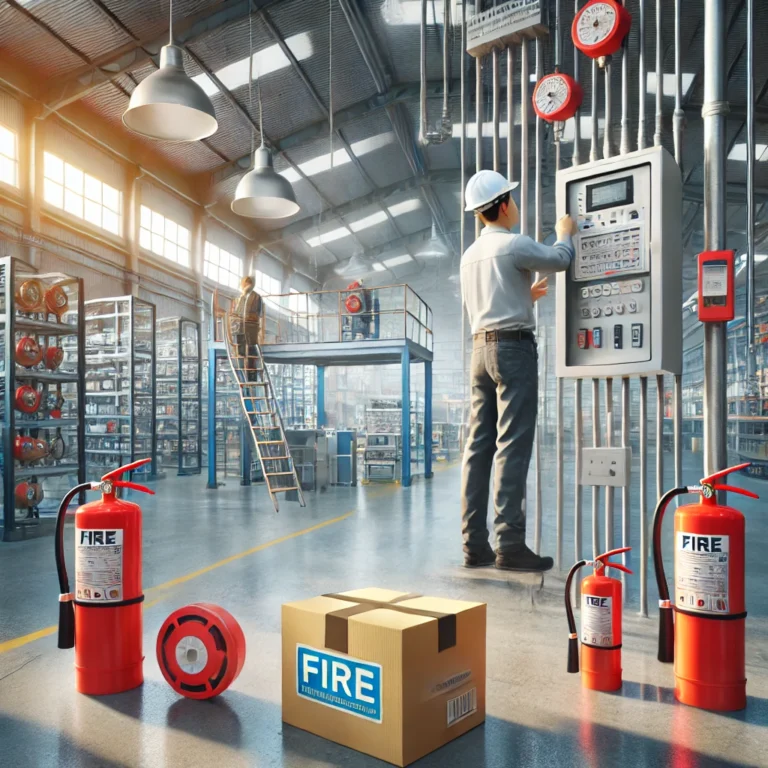Fire Protection Systems for Buildings: Safeguarding Lives and Property
Table of Contents
Fire is a force capable of causing unimaginable destruction, making fire protection systems an essential part of any building’s safety infrastructure. Whether you are a property owner, manager, or tenant, it’s crucial to understand how these systems work and why they are necessary. In this blog, we’ll explore the importance of fire protection systems, the types available, and how to choose the right one for your building.

Why Are Fire Protection Systems Essential?
Fire protection systems play a critical role in detecting, controlling, and extinguishing fires. They not only protect property but also save lives. Here are some key reasons why fire protection systems are essential:
1. Life Safety
The primary goal of any fire protection system is to protect the occupants of a building. Systems like fire alarms, smoke detectors, and sprinklers can detect fires early, allowing occupants to evacuate safely before the situation worsens.
2. Property Protection
Fires can cause severe damage to buildings and their contents. With fire protection systems in place, the spread of fire is minimized, which can significantly reduce property damage and the associated financial losses.
3. Compliance with Regulations
Many local and national fire safety codes mandate the installation of fire protection systems in both commercial and residential buildings. Compliance with these regulations is not only a legal requirement but also critical for ensuring the safety of the building’s occupants.
4. Insurance Requirements
Insurance companies often require fire protection systems as part of their coverage conditions. Having a system installed can help reduce premiums and ensure that you are fully covered in the event of a fire.
Types of Fire Protection Systems
There are various types of fire protection systems available, each designed to address different fire risks. Below are some of the most common systems:
1. Fire Alarm Systems
Fire alarms detect the presence of smoke, heat, or flames and alert building occupants through audible and visual signals. They can also be integrated with other fire protection systems, such as sprinklers, for a more comprehensive safety solution.
2. Sprinkler Systems
Sprinkler systems are highly effective in controlling and extinguishing fires. When a fire is detected, the sprinklers release water to suppress the flames. This system is ideal for minimizing property damage and controlling the spread of fire until firefighters arrive.
3. Fire Extinguishers
Portable fire extinguishers are designed to tackle small fires before they spread. They come in different classes, including Class A (ordinary combustibles), Class B (flammable liquids), and Class C (electrical fires). Fire extinguishers should be strategically placed throughout a building for quick access during an emergency.
4. Fire Suppression Systems
Fire suppression systems use specialized agents, such as clean gases or foam, to suppress fires in sensitive areas like server rooms, kitchens, or data centers. These systems are designed to quickly suppress fires while minimizing damage to equipment.
5. Smoke Control Systems
Smoke control systems manage the movement of smoke in a building, keeping evacuation routes clear and providing safer egress for occupants. These systems can include smoke curtains, smoke dampers, or pressurization systems to prevent smoke from spreading.
How to Choose the Right Fire Protection System
Selecting the correct fire protection system for your building requires careful consideration of several factors. Here are key points to consider:
1. Conduct a Risk Assessment
Evaluate the fire risks in your building by identifying potential hazards, such as flammable materials or electrical systems. This will help determine the level of fire protection required.
2. Understand Building Codes
Ensure that your fire protection system complies with local building codes and regulations. These codes will guide the type, design, and installation of the system in your specific building type.
3. Integrate Systems for Full Coverage
For maximum protection, consider integrating multiple fire protection systems. For example, combining fire alarms with sprinkler systems can provide a comprehensive fire response plan.
4. Maintenance and Inspections
Regular maintenance and inspections are crucial to keeping your fire protection system functional. Consider the long-term costs of maintaining your system and ensure it is easily serviced by qualified professionals.
5. Training and Education
Educating occupants and staff on fire safety is just as important as having a fire protection system. Ensure they know how to use fire extinguishers, respond to alarms, and evacuate safely in an emergency.
Importance of Fire Protection Piping Systems – SRJ
When it comes to fire protection, having a reliable fire protection piping system is essential. At SRJ Piping India, we offer high-quality piping systems designed for efficient fire suppression. Our systems are built to ensure consistent water flow and quick response times during a fire emergency. To learn more, visit our page on fire protection piping solutions.
For more information about fire safety regulations, you can explore NFPA’s Fire Safety Standards.
Conclusion
Fire protection systems are essential for safeguarding lives, property, and ensuring compliance with regulations. Whether it’s fire alarms, sprinklers, or suppression systems, choosing the right system for your building will provide peace of mind and reduce the risks associated with fire. Remember, regular maintenance and inspections are just as important as the initial installation.
For expert advice on installing fire protection systems, consult SRJ’s Fire Protection Services. Don’t wait until it’s too late—invest in the safety of your building and its occupants today.
Need Reliable Fire Protection for Your Building?
SRJ Piping India delivers end-to-end fire protection systems that safeguard both life and property—built to code, tested for crisis.
